Guangzhi Wang
ToonComposer: Streamlining Cartoon Production with Generative Post-Keyframing
Aug 14, 2025Abstract:Traditional cartoon and anime production involves keyframing, inbetweening, and colorization stages, which require intensive manual effort. Despite recent advances in AI, existing methods often handle these stages separately, leading to error accumulation and artifacts. For instance, inbetweening approaches struggle with large motions, while colorization methods require dense per-frame sketches. To address this, we introduce ToonComposer, a generative model that unifies inbetweening and colorization into a single post-keyframing stage. ToonComposer employs a sparse sketch injection mechanism to provide precise control using keyframe sketches. Additionally, it uses a cartoon adaptation method with the spatial low-rank adapter to tailor a modern video foundation model to the cartoon domain while keeping its temporal prior intact. Requiring as few as a single sketch and a colored reference frame, ToonComposer excels with sparse inputs, while also supporting multiple sketches at any temporal location for more precise motion control. This dual capability reduces manual workload and improves flexibility, empowering artists in real-world scenarios. To evaluate our model, we further created PKBench, a benchmark featuring human-drawn sketches that simulate real-world use cases. Our evaluation demonstrates that ToonComposer outperforms existing methods in visual quality, motion consistency, and production efficiency, offering a superior and more flexible solution for AI-assisted cartoon production.
BlobCtrl: A Unified and Flexible Framework for Element-level Image Generation and Editing
Mar 17, 2025Abstract:Element-level visual manipulation is essential in digital content creation, but current diffusion-based methods lack the precision and flexibility of traditional tools. In this work, we introduce BlobCtrl, a framework that unifies element-level generation and editing using a probabilistic blob-based representation. By employing blobs as visual primitives, our approach effectively decouples and represents spatial location, semantic content, and identity information, enabling precise element-level manipulation. Our key contributions include: 1) a dual-branch diffusion architecture with hierarchical feature fusion for seamless foreground-background integration; 2) a self-supervised training paradigm with tailored data augmentation and score functions; and 3) controllable dropout strategies to balance fidelity and diversity. To support further research, we introduce BlobData for large-scale training and BlobBench for systematic evaluation. Experiments show that BlobCtrl excels in various element-level manipulation tasks while maintaining computational efficiency, offering a practical solution for precise and flexible visual content creation. Project page: https://liyaowei-stu.github.io/project/BlobCtrl/
S3Editor: A Sparse Semantic-Disentangled Self-Training Framework for Face Video Editing
Apr 11, 2024Abstract:Face attribute editing plays a pivotal role in various applications. However, existing methods encounter challenges in achieving high-quality results while preserving identity, editing faithfulness, and temporal consistency. These challenges are rooted in issues related to the training pipeline, including limited supervision, architecture design, and optimization strategy. In this work, we introduce S3Editor, a Sparse Semantic-disentangled Self-training framework for face video editing. S3Editor is a generic solution that comprehensively addresses these challenges with three key contributions. Firstly, S3Editor adopts a self-training paradigm to enhance the training process through semi-supervision. Secondly, we propose a semantic disentangled architecture with a dynamic routing mechanism that accommodates diverse editing requirements. Thirdly, we present a structured sparse optimization schema that identifies and deactivates malicious neurons to further disentangle impacts from untarget attributes. S3Editor is model-agnostic and compatible with various editing approaches. Our extensive qualitative and quantitative results affirm that our approach significantly enhances identity preservation, editing fidelity, as well as temporal consistency.
Navigate Biopsy with Ultrasound under Augmented Reality Device: Towards Higher System Performance
Feb 04, 2024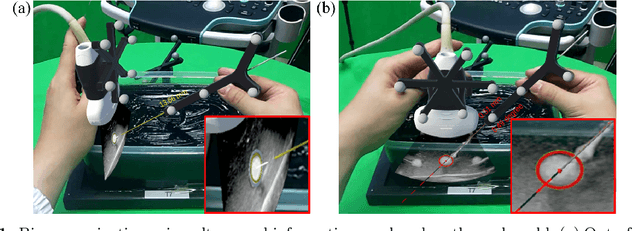
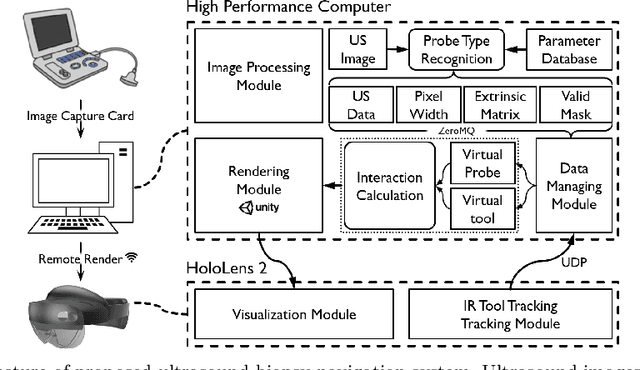
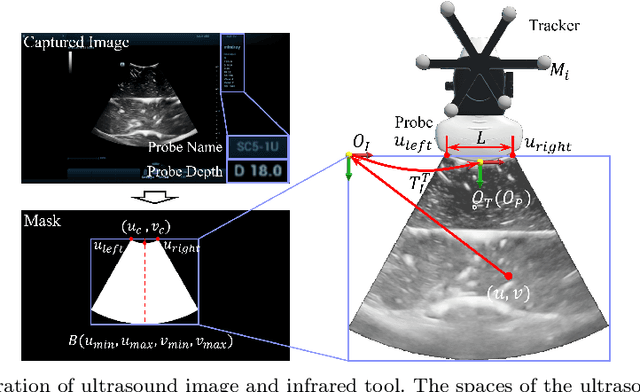

Abstract:Purpose: Biopsies play a crucial role in determining the classification and staging of tumors. Ultrasound is frequently used in this procedure to provide real-time anatomical information. Using augmented reality (AR), surgeons can visualize ultrasound data and spatial navigation information seamlessly integrated with real tissues. This innovation facilitates faster and more precise biopsy operations. Methods: We developed an AR biopsy navigation system with low display latency and high accuracy. Ultrasound data is initially read by an image capture card and streamed to Unity via net communication. In Unity, navigation information is rendered and transmitted to the HoloLens 2 device using holographic remoting. Retro-reflective tool tracking is implemented on the HoloLens 2, enabling simultaneous tracking of the ultrasound probe and biopsy needle. Distinct navigation information is provided during in-plane and out-of-plane punctuation. To evaluate the effectiveness of our system, we conducted a study involving ten participants, for puncture accuracy and biopsy time, comparing to traditional methods. Results: Our proposed framework enables ultrasound visualization in AR with only $16.22\pm11.45ms$ additional latency. Navigation accuracy reached $1.23\pm 0.68mm$ in the image plane and $0.95\pm 0.70mm$ outside the image plane. Remarkably, the utilization of our system led to $98\%$ and $95\%$ success rate in out-of-plane and in-plane biopsy. Conclusion: To sum up, this paper introduces an AR-based ultrasound biopsy navigation system characterized by high navigation accuracy and minimal latency. The system provides distinct visualization contents during in-plane and out-of-plane operations according to their different characteristics. Use case study in this paper proved that our system can help young surgeons perform biopsy faster and more accurately.
The Efficiency Spectrum of Large Language Models: An Algorithmic Survey
Dec 01, 2023Abstract:The rapid growth of Large Language Models (LLMs) has been a driving force in transforming various domains, reshaping the artificial general intelligence landscape. However, the increasing computational and memory demands of these models present substantial challenges, hindering both academic research and practical applications. To address these issues, a wide array of methods, including both algorithmic and hardware solutions, have been developed to enhance the efficiency of LLMs. This survey delivers a comprehensive review of algorithmic advancements aimed at improving LLM efficiency. Unlike other surveys that typically focus on specific areas such as training or model compression, this paper examines the multi-faceted dimensions of efficiency essential for the end-to-end algorithmic development of LLMs. Specifically, it covers various topics related to efficiency, including scaling laws, data utilization, architectural innovations, training and tuning strategies, and inference techniques. This paper aims to serve as a valuable resource for researchers and practitioners, laying the groundwork for future innovations in this critical research area. Our repository of relevant references is maintained at url{https://github.com/tding1/Efficient-LLM-Survey}.
SEED-Bench-2: Benchmarking Multimodal Large Language Models
Nov 28, 2023Abstract:Multimodal large language models (MLLMs), building upon the foundation of powerful large language models (LLMs), have recently demonstrated exceptional capabilities in generating not only texts but also images given interleaved multimodal inputs (acting like a combination of GPT-4V and DALL-E 3). However, existing MLLM benchmarks remain limited to assessing only models' comprehension ability of single image-text inputs, failing to keep up with the strides made in MLLMs. A comprehensive benchmark is imperative for investigating the progress and uncovering the limitations of current MLLMs. In this work, we categorize the capabilities of MLLMs into hierarchical levels from $L_0$ to $L_4$ based on the modalities they can accept and generate, and propose SEED-Bench-2, a comprehensive benchmark that evaluates the \textbf{hierarchical} capabilities of MLLMs. Specifically, SEED-Bench-2 comprises 24K multiple-choice questions with accurate human annotations, which spans 27 dimensions, including the evaluation of both text and image generation. Multiple-choice questions with groundtruth options derived from human annotation enables an objective and efficient assessment of model performance, eliminating the need for human or GPT intervention during evaluation. We further evaluate the performance of 23 prominent open-source MLLMs and summarize valuable observations. By revealing the limitations of existing MLLMs through extensive evaluations, we aim for SEED-Bench-2 to provide insights that will motivate future research towards the goal of General Artificial Intelligence. Dataset and evaluation code are available at \href{https://github.com/AILab-CVC/SEED-Bench}
PELA: Learning Parameter-Efficient Models with Low-Rank Approximation
Oct 16, 2023Abstract:Applying a pre-trained large model to downstream tasks is prohibitive under resource-constrained conditions. Recent dominant approaches for addressing efficiency issues involve adding a few learnable parameters to the fixed backbone model. This strategy, however, leads to more challenges in loading large models for downstream fine-tuning with limited resources. In this paper, we propose a novel method for increasing the parameter efficiency of pre-trained models by introducing an intermediate pre-training stage. To this end, we first employ low-rank approximation to compress the original large model and then devise a feature distillation module and a weight perturbation regularization module. These modules are specifically designed to enhance the low-rank model. Concretely, we update only the low-rank model while freezing the backbone parameters during pre-training. This allows for direct and efficient utilization of the low-rank model for downstream tasks. The proposed method achieves both efficiencies in terms of required parameters and computation time while maintaining comparable results with minimal modifications to the base architecture. Specifically, when applied to three vision-only and one vision-language Transformer models, our approach often demonstrates a $\sim$0.6 point decrease in performance while reducing the original parameter size by 1/3 to 2/3.
SEED-Bench: Benchmarking Multimodal LLMs with Generative Comprehension
Aug 02, 2023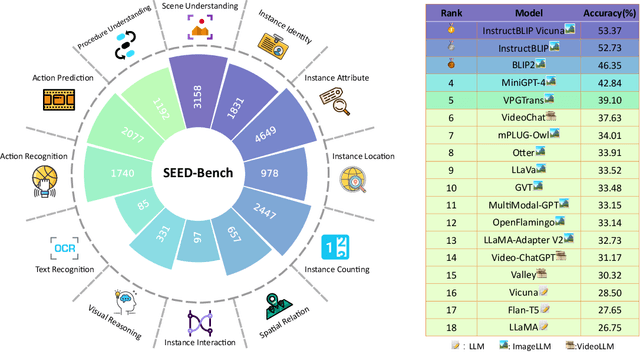

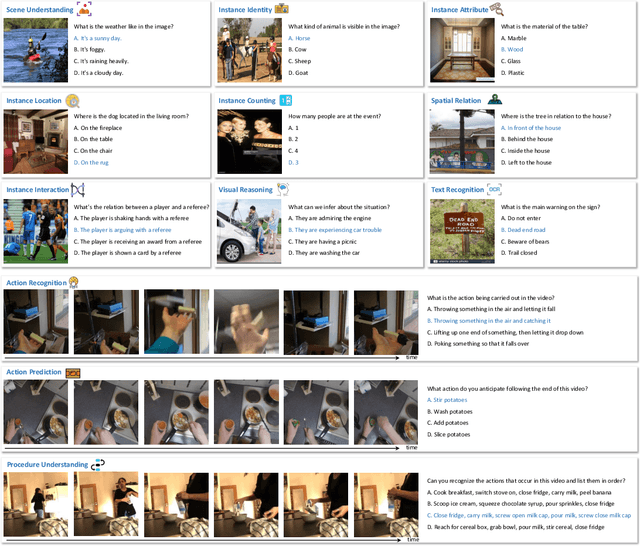
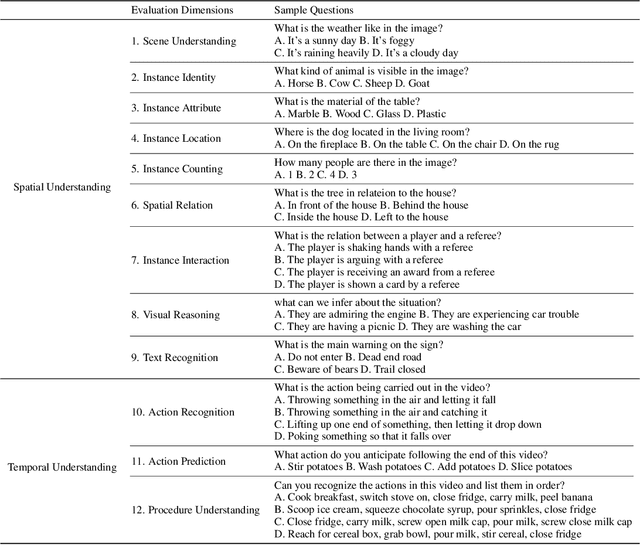
Abstract:Based on powerful Large Language Models (LLMs), recent generative Multimodal Large Language Models (MLLMs) have gained prominence as a pivotal research area, exhibiting remarkable capability for both comprehension and generation. In this work, we address the evaluation of generative comprehension in MLLMs as a preliminary step towards a comprehensive assessment of generative models, by introducing a benchmark named SEED-Bench. SEED-Bench consists of 19K multiple choice questions with accurate human annotations (x 6 larger than existing benchmarks), which spans 12 evaluation dimensions including the comprehension of both the image and video modality. We develop an advanced pipeline for generating multiple-choice questions that target specific evaluation dimensions, integrating both automatic filtering and manual verification processes. Multiple-choice questions with groundtruth options derived from human annotation enables an objective and efficient assessment of model performance, eliminating the need for human or GPT intervention during evaluation. We further evaluate the performance of 18 models across all 12 dimensions, covering both the spatial and temporal understanding. By revealing the limitations of existing MLLMs through evaluation results, we aim for SEED-Bench to provide insights for motivating future research. We will launch and consistently maintain a leaderboard to provide a platform for the community to assess and investigate model capability.
Mining Conditional Part Semantics with Occluded Extrapolation for Human-Object Interaction Detection
Jul 19, 2023



Abstract:Human-Object Interaction Detection is a crucial aspect of human-centric scene understanding, with important applications in various domains. Despite recent progress in this field, recognizing subtle and detailed interactions remains challenging. Existing methods try to use human-related clues to alleviate the difficulty, but rely heavily on external annotations or knowledge, limiting their practical applicability in real-world scenarios. In this work, we propose a novel Part Semantic Network (PSN) to solve this problem. The core of PSN is a Conditional Part Attention (CPA) mechanism, where human features are taken as keys and values, and the object feature is used as query for the computation in a cross-attention mechanism. In this way, our model learns to automatically focus on the most informative human parts conditioned on the involved object, generating more semantically meaningful features for interaction recognition. Additionally, we propose an Occluded Part Extrapolation (OPE) strategy to facilitate interaction recognition under occluded scenarios, which teaches the model to extrapolate detailed features from partially occluded ones. Our method consistently outperforms prior approaches on the V-COCO and HICO-DET datasets, without external data or extra annotations. Additional ablation studies validate the effectiveness of each component of our proposed method.
EVD Surgical Guidance with Retro-Reflective Tool Tracking and Spatial Reconstruction using Head-Mounted Augmented Reality Device
Jul 03, 2023



Abstract:Augmented Reality (AR) has been used to facilitate surgical guidance during External Ventricular Drain (EVD) surgery, reducing the risks of misplacement in manual operations. During this procedure, the key challenge is accurately estimating the spatial relationship between pre-operative images and actual patient anatomy in AR environment. This research proposes a novel framework utilizing Time of Flight (ToF) depth sensors integrated in commercially available AR Head Mounted Devices (HMD) for precise EVD surgical guidance. As previous studies have proven depth errors for ToF sensors, we first assessed their properties on AR-HMDs. Subsequently, a depth error model and patient-specific parameter identification method are introduced for accurate surface information. A tracking pipeline combining retro-reflective markers and point clouds is then proposed for accurate head tracking. The head surface is reconstructed using depth data for spatial registration, avoiding fixing tracking targets rigidly on the patient's skull. Firstly, $7.580\pm 1.488 mm$ depth value error was revealed on human skin, indicating the significance of depth correction. Our results showed that the error was reduced by over $85\%$ using proposed depth correction method on head phantoms in different materials. Meanwhile, the head surface reconstructed with corrected depth data achieved sub-millimetre accuracy. An experiment on sheep head revealed $0.79 mm$ reconstruction error. Furthermore, a user study was conducted for the performance in simulated EVD surgery, where five surgeons performed nine k-wire injections on a head phantom with virtual guidance. Results of this study revealed $2.09 \pm 0.16 mm$ translational accuracy and $2.97\pm 0.91$ degree orientational accuracy.
 Add to Chrome
Add to Chrome Add to Firefox
Add to Firefox Add to Edge
Add to Edge